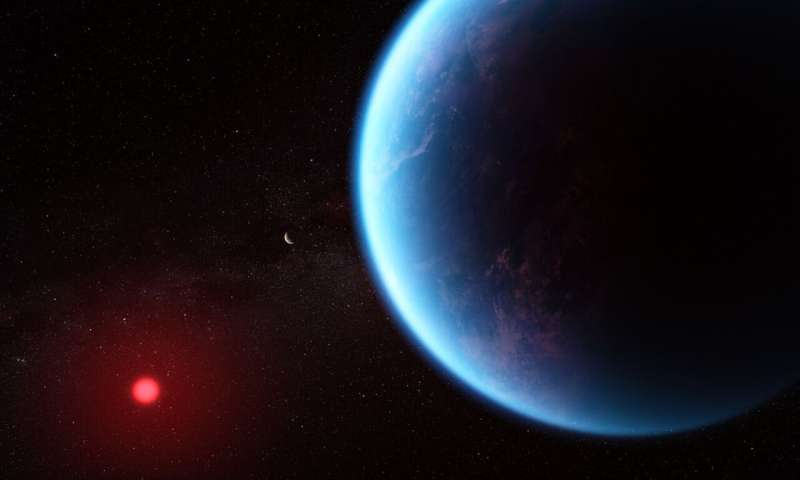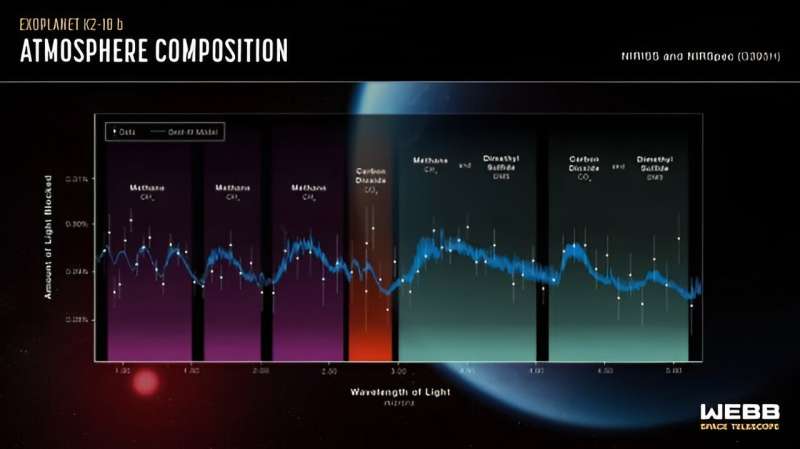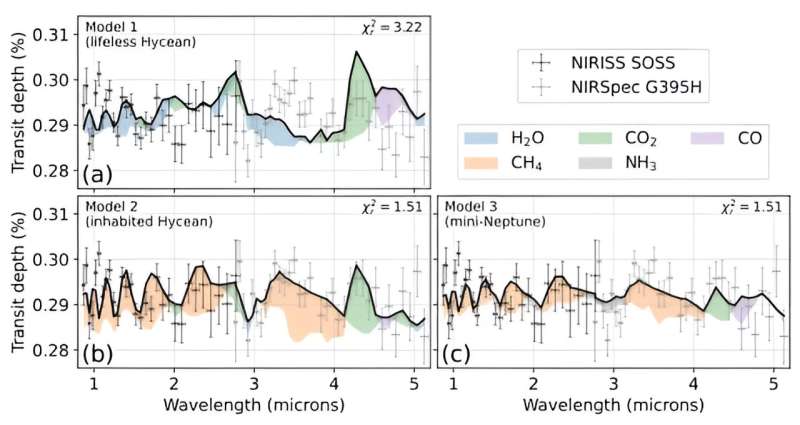This article has been reviewed according to Science X's editorial process and policies. Editors have highlighted the following attributes while ensuring the content's credibility:
fact-checked
preprint
trusted source
proofread
Another explanation for K2-18b? A gas-rich mini-Neptune with no habitable surface

Exoplanet K2-18b is garnering a lot of attention. James Webb Space Telescope spectroscopy shows it has carbon and methane in its atmosphere. Those results, along with other observations, suggest the planet could be a long-hypothesized "Hycean World." But new research counters that.
Instead, the planet could be a gaseous mini-Neptune.
K2-18b is in the habitable zone of a red dwarf star about 134 light-years away. It's about 2.6 Earth radii and about 8.6 Earth masses. Its orbital period is only 33 days, so it's close to its star. But since the star is a dim red dwarf, K2-18b receives about the same amount of energy from its star as Earth does from the sun.
Scientists are still puzzling over the planet's density and composition. Its density is in between the densities of Earth and Neptune. Since it's not predominantly rock like Earth or all gas like Neptune, that led to speculation that it's a hycean (ocean) world. The only way scientists can determine what K2-18b is made of is to discover what's in its atmosphere.
That's what the JWST did, and its observations found a number of chemicals, including CO2 and methane. It also found a lack of ammonia.
Earlier this month, scientists presented some research on the arXiv preprint server (Shorttle et al, 2024) based on the JWST's findings. By working with climate atmosphere models, those researchers concluded that K2-18b is most likely a magma ocean world. "The magma ocean model reproduces the present JWST spectrum of K2-18b," they wrote, "… suggesting this is as credible an explanation for current observations as the planet hosting a liquid water ocean."

But another group of researchers don't agree with that. Those researchers don't think the planet is a hycean world or a lava world. They've presented a paper, also on arXiv, titled "JWST observations of K2-18b can be explained by a gas-rich mini-Neptune with no habitable surface." The lead author is Nicholas Wogan, a post-doctoral researcher in the Space Science Division at NASA's Ames Research Center. Wogan studies the early Earth, as well as exoplanets and astrobiology.
The JWST found methane (CH4) and carbon dioxide (CO2) in K2-18b's atmosphere, and it also detected no ammonia. Those results generally indicate a hycean world with a thick hydrogen/helium atmosphere. But Shorttle et al's analysis showed otherwise, saying that the results could also show a planet with a magma world.
The new paper from Wogan et al comes to a different conclusion. "… we favor the mini-Neptune interpretation because of its relative simplicity and because it does not need a biosphere or other unknown source of methane to explain the data," they write.
In their work, the researchers used photochemical and climate models to simulate different versions of K2-18b, including hycean worlds and a gas-rich mini-Neptune with no defined surface. Their work shows that the gas-rich mini-Neptune model fits the data best.
There's an extraordinary amount of complexity in planetary atmospheres, and figuring out what's going on from such a great distance is an enormous task. Not only do scientists need to know what chemicals are present (thanks, JWST), but they need to understand all the processes taking place. The temperature and pressure in an atmosphere play huge roles in what we can see and in what may remain hidden.
One aspect of K2-18b's atmosphere is supercriticality. A supercritical fluid is one that's above its critical point in temperature and pressure. Above this critical point, neither gas nor liquid phases exist. But the pressure isn't high enough to force the material into a solid. Jupiter and Saturn have supercritical fluids deep in their atmosphere, and they behave very differently than liquids or gases. That adds another layer of complexity.

Researchers have climate models that embody the complexity as best they can, and the researchers compared the JWST's findings to three modeled exoplanets: an uninhabitable hycean world, a habitable hycean world, and a gaseous mini-Neptune with no surface.
"Given the additional obstacles to maintaining a stable temperate climate on Hycean worlds due to H2 escape and potential supercriticality at depth, we favor the mini-Neptune interpretation because of its relative simplicity and because it does not need a biosphere or other unknown source of methane to explain the data," the authors write.
The authors point out that for a hycean world to maintain its 1% atmospheric methane, there would need to be a biogenic source or some other unknown source. They also write that if K2-18b is a hycean world, it would be very difficult for it to avoid the runaway greenhouse effect and maintain a stable temperature. The authors discard the hycean hypothesis because it is full of challenges. According to them, a gaseous mini-Neptune scenario fits the data and models better.
They point to the planet's deep atmosphere to explain the JWST's findings. "Deep-atmosphere thermochemical quenching" can explain the methane and carbon dioxide that JWST found, and deep atmosphere kinetics like upwelling can explain the lack of ammonia and carbon monoxide.
This won't be the last word on K2-18b. The data will be subjected to further analysis. As the effort to understand it continues, the results will also strengthen our existing atmospheric and climate models. One day in the future, scientists will know how to differentiate exoplanets.
But for now, they're still figuring it out.
More information: Nicholas F. Wogan et al, JWST observations of K2-18b can be explained by a gas-rich mini-Neptune with no habitable surface, arXiv (2024). DOI: 10.48550/arxiv.2401.11082
Journal information: arXiv
Provided by Universe Today





















